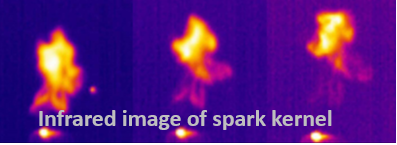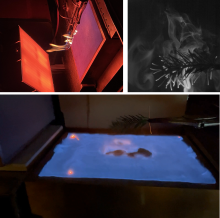Home Highlights Our Team CIRE Lab Propulsion Lab Dr. David Blunck Publications Media Coverage
2000 SW Monroe Avenue, Room #334, Corvallis, OR, 97322
The focus of the Combustion, Ignition, Radiation, and Energy Laboratory (CIRE Lab) is using research to gain fundamental understanding to help address challenges related to controlling forest fires, increasing the efficiency of energy conversion systems, and improving propulsion devices. In short, the group strives to make sure that both the fundamental science and the application are addressed through research.
 |
CombustionKnowledge about the combustion characteristics of solid fuels (e.g. forest material) and large hydrocarbon fuels (e.g., jet fuels) is relatively limited. This is significant because this knowledge is needed to design combustion devices which are more efficient and produce less pollution and to develop or evaluate models to protect human lives and property. The group is addressing this need by performing cutting-edge research into deflagration and detonation combustion processes. We accomplish this using unique capabilities including subatmospheric and remote test capabilities. |
 |
IgnitionIgnition of engines, combustors for scramjets, and forest fire material can be a challenge. Unfortunately, significant gaps remain in our understanding about the ignition process. To help address these gaps, the group has performed ground-breaking research into measuring the temperature of ignition kernels and will be investigating ignition of forest fires. |
 |
RadiationInfrared radiation is a significant marker of the temperature and species distribution within reacting and non-reacting flows. The group has pioneered techniques which use infrared radiation measurements as a non-intrusive diagnostics tool for studying flows. These techniques have been applied to investigate carbon dioxide emissions from streams, drying of pharmaceutical materials, ignition in scramjets, and radiation emissions from flames. |
 |
EnergyThe group is actively pursuing research to develop a pulse detonation engine that can be coupled with a magnetohydrodynamic section to generate electricity and prepare the flow for a turbine. This research can help enable power generation plants which operate at substantially higher efficiencies. |
The Blunck group is always seeking new opportunities for collaboration with groups from government or industry, including people outside of engineering. The group actively communicates with companies (e.g., General Electric, Pratt and Whitney), the Department of Defense (e.g., AFRL, NRL), and the Department of Energy (e.g., NETL). This allows us to gain an appreciation for challenges or limitations in practical systems and conduct research which is relevant.
- Background: Live fuels make up a significant portion of wildland fuels, yet there is no unifying theory of how live fuels ignite and burn. Current wildland fire models use assumptions about live fuels that have been shown to be inaccurate.
- Research Focus: The objective of this project is to gain a better understanding of the physical processes by which live fuels ignite and burn. This will be accomplished by identifying key physical and chemical processes that cause ignition, and by improving models for fuel consumption in live fuels.

The study using a network reactor model in wood stove design aims to enhance the evaluation and optimization of combustion systems by integrating detailed chemical reaction processes with essential transport phenomena. Recognizing the limitations of traditional models that often neglect fluid dynamics and high-fidelity heat and mass transfer, this approach incorporates the complexities of radiative and convective heat transfer that drive pyrolysis and devolatilization in solid fuel combustion. By coupling network reaction models with comprehensive wood combustion and heat transfer models, the research seeks to accurately simulate the introduction of gas-phase fuels, local air flow rates, and velocities. This integrated model leverages combustion chemistry, including NOx and soot formation, to address the nuanced interaction between chemical reactions and thermal processes. Ultimately, this approach promises to improve the performance and the emissions characteristics of wood-burning stoves, offering a more robust tool for design and analysis in solid fuel combustion applications.
Wildland fire modeling is challenged by still unexplained differences between the ignition of live and dead vegetative fuel. Ignition is controlled by the release of combustible vapors from the solid fuel. An understanding of how these vapors are released is critical to our efforts to better understand and model the ignition behavior of wildland fire fuels. My work seeks to identify the most important combustible vapors, and how they are released from the solid fuel in the lead-up to ignition. To study this process, I’ve developed a method to quantify the most abundant vapors released from the fuel, and have found fundamental differences in the release of these vapors among fuel types.

Coming soon